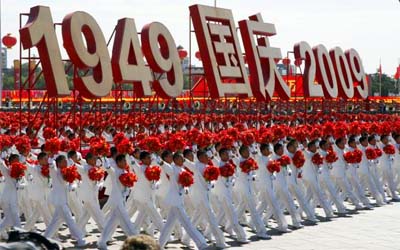The iconography of a military parade is seemingly at odds with China’s general effort to avoid arousing international concern about its rise, suggesting, instead, that this is for a domestic audience. China’s leadership politics is as opaque as ever, but the parade remains an event primarily designed for the domestic audience. It is meant to educate, excite, unite and entertain. If a tad of ‘shock and awe’ is delivered around the world, all well and good. But as the old Party cliché holds, such events must essentially satisfy the ‘two olds’ (er lao): the ‘Old Cadres’ (lao ganbu) and the ‘Old Hundred Names’ (lao baixing), that is, the broad masses of Chinese people.
Having said this, we should remember that, apart from those up on the rostrum of Tiananmen Gate, the parade and the festivities are primarily produced for a local television audience. As they have for sixty long years, the residents of the capital provide the fodder, the backdrop, the crowds, and the logistical wherewithal for the lavish display, but they are not its target audience. For the most part, locals are required to stay off the streets, keep indoors, and make like the rest of the country: behave and watch the show on the tube.
China has a rich history of military parades, during the Qing dynasty, victory parades were frequently organized for the emperor. During this era, there was the revival of the ancient tradition of Tours of the South (nanxun), that is, imperial tours of the southern provinces. These tours were like a moving triumph or parade of strength. The most recent ‘tour of the south’ was conducted by Deng Xiaoping and his entourage in 1992.
The Chinese revolution featured parades from its earliest days. Of course, I’m referring to the Republican revolution of the nineteen-tens, which is now all too easily forgotten or overshadowed by the successful Communist insurgency of 1946-49. Yuan Shikai, president of the republic, reviewed troops from the newly built Xinhua (New China) Gate, built as the formal entrance to the government compound of the Lake Palaces (Zhongnan Hai), which is still the heart of the country’s political power. He even mounted a stead and joined the review himself along what is now Chang’an Avenue.
Local parades of have been a feature of the Communist Party’s revolutionary politics since the nineteen-twenties. Party organizers encouraged local uprisings and then enjoined the peasants to parade members of the gentry before ritual denunciations and executions. However, the days of violent and militant slogans in National Day parades are long gone. Now harmony and light reign supreme.
Over the life of the People’s Republic, the National Day celebrations have been a barometer of the national psyche at that moment. One of the most revealing moments from past mass spectacles, is the 1984 parade celebrating the thirty-fifth anniversary of the People’s Republic and, by fortunate coincidence, Deng Xiaoping’s eightieth birthday. This featured a rare spontaneous moment: a group of Peking University students marching in the parade held up a home-made sign that said ‘Xiaoping, nin hao!’ (‘Hello, Xiaoping!’). Of course, the official filmmakers didn’t have the outburst in their script, so they failed to capture the moment on film. After discussion, negotiation and high-level agreement, the spontaneous outburst was restaged, filmed and duly edited into the official account of the parade. Such good-natured outpourings of emotion have not been a feature of subsequent National Day parades, of which the 1989 celebration, coming so soon after June 4th, was particularly grim.
The selection of slogans has always been a gauge of the party-state’s mood at the moment of the parade. Sadly, since the nineteen-eighties, the lacklustre bureaucratese of Deng Xiaoping and his technocratic successors has consistently assured us of bland and turgid sloganeering.
Invariably, this time around there was the usual nostrums related to Hu Jintao’s much touted but deeply troubled ‘harmonious society’ (hexie shehui) and the ‘scientific developmental strategy,’ which is his vaunted theoretical contribution to ‘Marxism-Leninism-Mao Zedong Thought-Deng Xiaoping Theory and Jiang Zemin-ideas.’
National unity was also a feature, something aimed at symbolically assuring everyone that the borderland uprisings since 2008 are but the work of a few malcontents in cahoots with international splittist schemers. Those in doubt just had to see the police and military hardware that was out in force.
As with the Olympic Opening Ceremony, however, there was a series of vague formulations about China’s peaceful rise on the world stage and its non-aggressive and inclusive approach to global affairs. Design by committee may produce good mass spectacle, but anything truly inventive or quirky ends up as an outtake.
Zhang Yimou, the overall director of the civilian parade and party, is sadly more than familiar with the painful necessity to ‘shoot your babies.’


Why does China still conduct parades?
Given China’s history from 1840 onwards, it is important to understand the importance of parades to the Chinese populace rather than simply a means by which the Communist Party maintains control.
Military Parades inspire national pride and inform viewers that modern China is more than capable of defending itself-something China rightfully considers important as a victim of the opium wars and the unequal treaties.
Secondly, other countries which never suffered a ‘century of humiliation’ continue the tradition of military parades. France and Russia come to mind, and the United States practices something akin to a ‘military parade’ with F-15s flying over the American superbowl.
What I find amazing is how people hate it when the Prussian/German Army goose step but they never complain when Russian Army, Polish Army and some of the former Communist Armies are still using the goose step. You think they would have gotten rid if since they had a negative attitude towards it because of Nazis and Communist rule.
You look at the US Marine Corp, they have that Sunset Parade in Washington D. C. plus the Army has the US Army Old Guard.